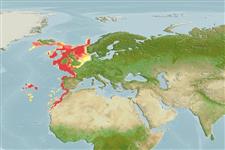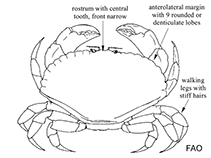Cancer bellianus Johnston, 1861
Toothed rock crab| Native range | All suitable habitat | Point map | Year 2050 |

|
| This map was computer-generated and has not yet been reviewed. |
| Cancer bellianus AquaMaps Data sources: GBIF OBIS |
Upload your photos
Google image | No image available for this species;
drawing shows typical species in Cancridae.
Google image | No image available for this species;
drawing shows typical species in Cancridae.
Classification / Names Common names | Synonyms | CoL | ITIS | WoRMS
Malacostraca | Decapoda | Cancridae
Environment: milieu / climate zone / depth range / distribution range Ecology
Benthic; depth range 37 - 750 m (Ref. 356). Temperate; 71°N - 22°N, 34°W - 7°E
Distribution Countries | FAO areas | Ecosystems | Occurrences | Introductions
Eastern Atlantic: from Morocco to Atlantic coast of Europe and southern coast of Iceland.
Length at first maturity / Size / Weight / Age
Maturity: Lm 10.5, range 13 - ? cm Max length : 22.1 cm CW male/unsexed; (Ref. 2761); max. published weight: 1.9 kg (Ref. 2761)
Maximum carapace width: 20.0 cm (Ref. 435). Higher rate of female individuals in shallower strata, 200 to 400 m, and male individuals has a higher rate in deeper strata, 400 to 600 m. Landings of 10,000 per year (Ref. 2753). Unimodal size frequency distribution for both sexes (Ref. 2753, 2761). Occurs at depths from 37 to 700 m (Ref. 2761; 150 to 750 m in Ref. 356; 37 to 620 m in Ref. 435; and sublittoral to 700 m in Ref. 2753). Found on varied substrata (Ref. 2761). In general, species under the family Cancridae are omnivores, predators, or scavengers (Ref. 3477)
Life cycle and mating behavior Maturity | Reproduction | Spawning | Eggs | Fecundity | Larvae
Exhibits spawning migration that results in ovigerous females occupying different territory from the rest of the population (Ref. 2753).
Main reference
References | Coordinator | Collaborators
Fischer, W., G. Bianchi and W.B. Scott (eds.). 1981. (Ref. 435)
IUCN Red List Status (Ref. 130435)
CITES status (Ref. 108899)
Not Evaluated
CMS (Ref. 116361)
Not Evaluated
Threat to humans
Human uses
Fisheries: commercial
| FishSource | Sea Around Us
Tools
More information
Internet sources
BHL | BOLD Systems | CISTI | DiscoverLife | FAO(Publication : search) | Fishipedia | GenBank (genome, nucleotide) | GloBI | Gomexsi | Google Books | Google Scholar | Google | PubMed | Tree of Life | Wikipedia (Go, Search) | Zoological Record
Estimates based on models
Preferred temperature
(Ref. 115969): 6.8 - 14.1, mean 9.6 (based on 211 cells).
Resilience
(Ref. 69278):
High, minimum population doubling time less than 15 months (Fec=484,800).
Price category
(Ref. 80766):
Unknown.



